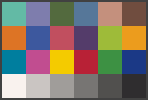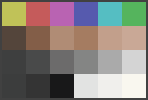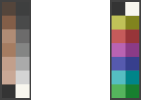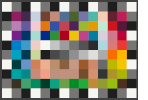Which Color Card to Use?
If you already have one, then I recommend that use that one. The differences between the results of using MBR Color Corrector 3 with any of the cards are minor. But, if you don't have a color card yet, then there are some things to consider:Practical Concerns
The biggest concern is the size of the card, for example the size of the card you need for close up talking head style shots will be smaller than that required for drone shots. Additionally, some of the cards come with cases to prevent damage to the card when not in use.
The various color cards have the following approximate sizes / cases:
 |
Datacolor SpyderCHECKR | 31 x 23 cm, | comes with a hard case | ||
 |
Datacolor SpyderCHECKR 24 | 23 x 14 cm | |||
 |
Calibrite/X-Rite ColorChecker Classic | 4 x 3 cm (Nano) 9 x 6 cm (Mini) 28 x 22 cm 54 x 38 cm (XL), |
XL size optionally comes with a soft case | ||
 |
Calibrite/X-Rite ColorChecker Passport Photo (1 or 2) | 11 x 7 cm, | comes with a very durable hard case | ||
 |
Calibrite/X-Rite ColorChecker Passport Video | 11 x 7 cm, | comes with a very durable hard case | ||
 |
Calibrite/X-Rite ColorChecker Video | 28 x 22 cm 54 x 38 cm (XL) |
XL size optionally comes with a soft case | ||
 |
Calibrite/X-Rite ColorChecker Digital SG | 28 x 22 cm |
In practice the 28 x 22 cm X-Rite cards and the 32 x 23 cm Datacolor
SpyderCHECKR card are about the right size for most normal
footage.
Cost is another practical concern, the X-Rite XL sized cards, and the X-Rite ColorChecker Digital SG are much more expensive than any of the other cards.
Photo
or Video
Color Card?
When using MBR Color Corrector 3 it doesn't really affect the quality of the
results if you use a photo
or a video
card.
Internally MBR Color Corrector tries to match the color patches on the card
to known / reference values, and it treats every patch as equally important.
This means that choice of a video
color card will slightly bias the color
correction towards getting skin tones correct, at the expense of other natural
colors. (This is because, video
cards have more skin tone examples and
proportionally fewer other natural colors).
Photo
Cards
In 1976 the Gretag Macbeth Charts were designed, and now that design of card is the X-Rite ColorChecker Classic. The chart’s color patches have spectral reflectances intended to mimic those of natural objects such as human skin, foliage, and flowers. A set of greyscale patches are included to help exposure settings, and a set of primary/secondary colors are included that represent colors not usually found in nature.
The Datacolor SpyderCHECKR 24, X-Rite ColorChecker Classic, and
X-Rite ColorChecker Passport Photo are all photo
cards. In all cases
they are similar to the original Gretag Macbeth cards. (The newer X-Rite cards
use slightly different ink and the Datacolor SpyderCHECKR 24 has very similar
color patches in a slightly different order, but it is effectively the same).
Video
Cards
In 2015 X-Rite released the video
cards. The X-Rite ColorChecker
Video and X-Rite ColorChecker Passport Video, when compared to photo
cards have:
- More skin tone patches
- More grayscale patches
- Desaturated colors from all around the color wheel
- But, none of the natural color patches found on the original
photo
cards
Some of these patches should make it easier to set you camera up while shooting:
- The greyscale patches means that you could use a level meter to see which patches are clipped to black or white.
- The desaturated colors from all around the color wheel means that you can use a vectorscope to check the angles of those patches to check the camera is set up correctly.
Combined Photo
and Video
Cards
Two cards have the additional features of a video
card without loosing
any of the color patches found on the photo
cards:
The Datacolor SpyderCHECKR contains (in the right hand pane) the original 24
photo
color patches, and has 24 video
color patches in the left
hand pane. These extra patches contain a collection of skin tones, extra shades
of gray, and the desaturated colors around the color wheel that are useful with
video
cards while shooting.
The X-Rite ColorChecker Digital SG contains (in the upper middle) the
original 24 photo
color patches, and around it about 100 more patches.
These extra patches contain many skin tones, and many many fairly saturated
colors from around the color wheel to show exactly how a camera responds.
My Personal View
Personally, I would recommend the Datacolor SpyderCHECKR (with 48 patches) for most uses, and the X-Rite ColorChecker Passport Photo or Passport Video if you shoot almost exclusively close up "talking head" shots.
The Datacolor SpyderCHECKR (with 48 patches) is effectively a photo
chart and a video
chart combined in a sensible size for most shots.
The X-Rite ColorChecker Passport Photo / Passport Video are smaller and
therefore ideal for close up shots.
All three of these cards come with a reasonable hard case, which means they have a reasonable chance of remaining undamaged in a kit bag.